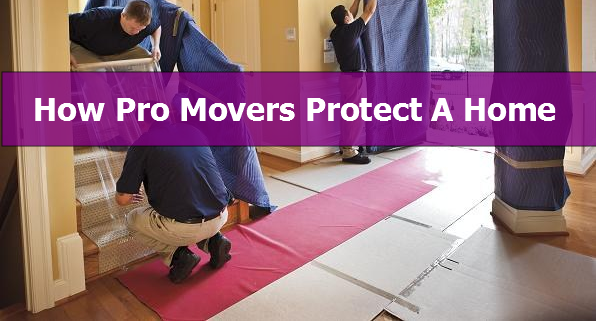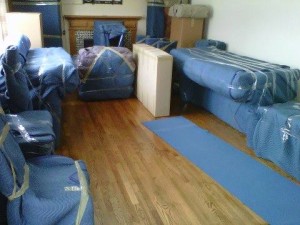The protection and preparation of the home is often one of the first and most essential phases of the moving process. Neglecting to do so can lead to damages, claims and a not so happy customer.
Most movers have their own specific ways to protect areas and many are even prideful enough in their work to argue about it. But take it from professional Allied Van Lines mover Matthew Sochowski who says, “There are actually several different methods to protect the surroundings. They all can achieve the same goal, just different ways to go about it. There is no real right answer.” So really, there can be several ways to protect the home, just as long as it’s protected.
The content that resides in this article was inspired from the contributions of many professional movers from around the world and I thank them for the time and thoughts they have provided me on this subject.
From zone to zone, we are going to show you some of the best ways that professional movers prepare and protect the home during a move.
1. The Movers’ Attire
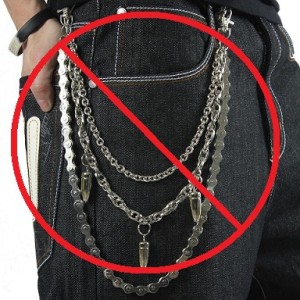
Don’t be this guy. Protection of the home begins with the attire of the movers themselves. Movers should not have any loose chains, large rings, large zippers, or other protruding metal on their bodies that may rub up against fragile surfaces or scratch walls.
2. The Moving Truck – Don’t Forget

The moving truck should be properly prepared before the move starts. Make sure the wheels are chocked and the e-brake is engaged. Claims involving the moving truck inside the neighbor’s dining room are never good for you, or your home’s curb appeal.
3. Protecting The Floors For Moving
Different types of flooring call for different kinds of protection. When protecting floors in the home, the goal is to create pathways in which you use to walk on, roll dollies on, move furniture etc. Watch The Video to see an example of how a professional moving company protects your floors.
Hard Floors
The industry standard for protecting hardwood floors, tile, linoleum, and other hard floor surfaces is something called rug-runners. These are basically a roll of thin carpet you lay out over the floors creating a path for the movers to walk. It is recommended that rug-runners have a good rubber bottom and be taped down with masking tape or painters tape to keep them from moving around. You should not put packing tape on the floors, sometimes they will leave residue or pull up the finish.
You can also put Masonite boards on top of the rug-runners for extra protection if necessary.
Carpet
There are a few ways professional movers protect carpets during a move. The best way is to lay out Masonite boards to create protection and a hard rolling surface. The Masonite boards are then taped at the seams to keep them from moving. Be mindful of the condition of the Masonite boards as they may get old and leave behind dirt or particles. You can also lay down rug runners, foam roll, or furniture pads before the Masonite boards to create extra protection.

Another way that carpet can be protected is with carpet mask. Carpet mask is a thin layer of plastic that is sticky on one side and rolled out over the carpet. Carpet mask is good for keeping the carpets clean, but not as good for rolling heavy furniture on, as it doesn’t create a hard surface. For moving, carpet mask is used mainly for protecting carpeted stairs.
Stairs
Depending on whether the stairs or carpeted or a hard surface determines what protection is used. If the stairs are carpeted then carpet mask is used. If stairs are a hard surface such as hardwood, then a rug-runner is used and taped down very neatly to keep it in place.

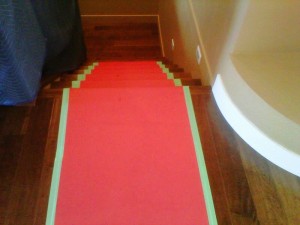
4. Protecting Banisters and Railings


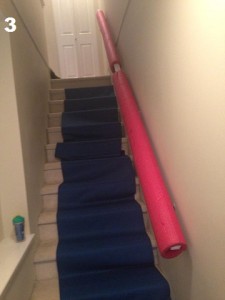
Banisters can be protected in a few different ways and it mainly comes down to personal preference. Some professionals prefer to use the crafted banister protectors (1) and some will simply drape over furniture pads securing them with tape (2). Some professional movers will even get creative and use pool toys (3) to protect banisters. In any case be sure the banisters and railings are protected all the way around.
Keeping Door Jambs Safe
Door jambs can be protected in a few different ways depending on what you have and the possibilities of damage. If you do not have specific door jamb protectors you can simply fabricate one out of a furniture pad or folded pieces of cardboard. Although this may work and provide protection, it will certainly take more time and effort.
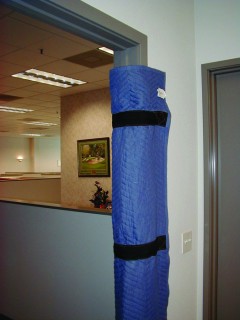
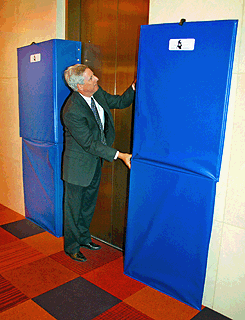
The best ways to protect door jambs for moving is by using specific products for that purpose. Similar to banister protectors, door jamb protectors are made to fit and clamp to the door jamb in one simple step.
Another great product is Matadoors (right image). Matadoors are pads that hook to door jams and provide extra padding and protection. Some professionals may say that these are too much and not reasonable to use.
Don’t forget to protect all areas of the door frame, especially ones with glass above or around the front doors.
6. Protecting Hallways and Walls
Depending the extent of possible damage, you may need to protect the walls in certain places of the home. It is recommended to protect the walls with Masonite or cardboard. You can also use furniture pads in areas where you can hang or drape them such as underneath banisters on stairs.
7. Bad Weather and Home Protection
Bad weather is always challenge when attempting to keep floors clean and protected during a move. Even after all the procedures of protecting the home are taken, it is likely that moisture, dirt and other debris will be tracked into the home from outside. In these cases the best option is to have outside movers and inside movers. Outside movers will bring items off the truck into a garage or dry entryway and inside movers will distribute items from inside the house.
Another precaution that needs to be considered during bad weather is creating a pathway from the truck to the home. This is needed if it is icy outside so movers don’t slip and damage items.
Acknowledgements
A special thanks to all of our professional movers in the Facebook group Movers who helped with this article: Jodi Cooper, Matthew Sochowski, Jed Dye, Lorence Triplett, James David Sharpe, Robert Owen, Kyle Robinson, Tyler Lawson Peart, Tyler M. Lovdahl, Chris Pietrzyk Boyes, Frank Cameron, Lance Park, Tony Ynot, Jaid El Puma, Dallon Springchief, Kevin Sawatzky, Mike Joseph Berg, Andy Sawatzky, Ron Pridmore, Scott Boyd, and Donny Campbell.
We do not believe any article is complete without comments and opinions. Please let us know what you think and if you would like to add any additional information.
**If you like this content please help Moversville by commenting, liking, sharing, and tweeting**
